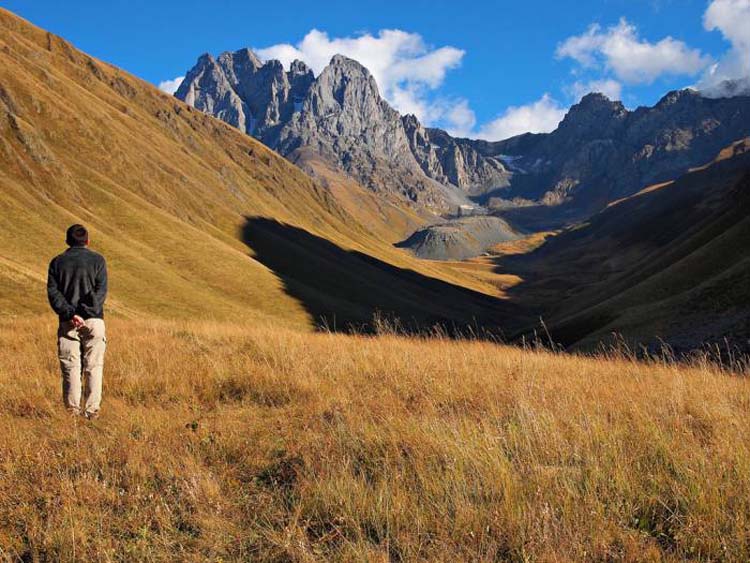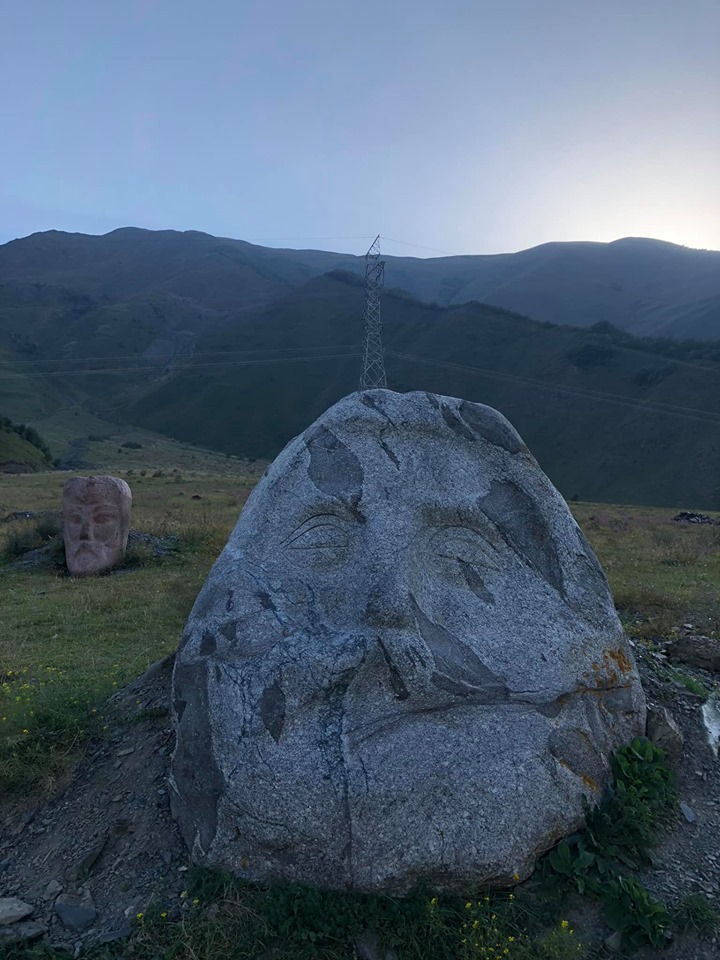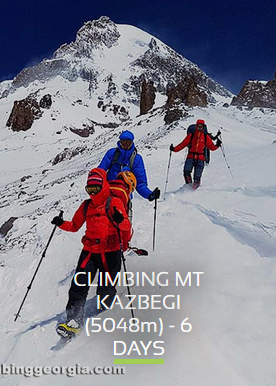




Around Mt. Kazbegi
KAZBEGI
https://goo.gl/maps/TTFwmuoxTr82
STEPANTSMINDA
The small town of Stepantsminda, formerly known as Kazbegi, is situated at an elevation of 1700 meters above sea level in the Mtskheta-Mtianeti region of northeastern Georgia. From both a historical and ethnographic standpoint, the town is intricately connected to the Khevi province. It serves as the central hub of the Kazbegi Municipality.
Resting along the banks of the Terek River, Stepantsminda is positioned 157 kilometers (98 miles) to the north of Tbilisi. The climate in Stepantsminda is characterized by moderate humidity, with relatively dry, chilly winters and extended, mild summers. The town is encompassed by imposing mountains on all sides, with Mount Kazbek, the region's most prominent peak, situated immediately to the west of the town.
The naming of Stepantsminda, which translates to "Saint Stephan," is rooted in tradition. Legend holds that a Georgian Orthodox monk named Stephan established a hermitage at this location, which later evolved into the Georgian Military Highway.
The name "Kazbegi" also has ties to the renowned Georgian writer Alexander Kazbegi (1848–1893). Alexander Kazbegi was the great-grandson of Kazibek Chopikashvili, a local feudal magnate who was responsible for collecting tolls on the Georgian Military Highway. After studying in Tbilisi, Saint Petersburg, and Moscow, Alexander Kazbegi returned to his hometown and took on the role of a shepherd to gain insight into the lives of the local people. He subsequently pursued a career as a journalist, followed by a transition into being a novelist and playwright. The final resting place of Alexander Kazbegi is within his ancestor's former residence, which now serves as a museum in his honor. A monument dedicated to the writer stands in the heart of the town.
BORDER WITH RUSSIA
The "Verchni Lars" border crossing between Georgia and Russia was opened on March 1, 2010. This border crossing operates during the winter period (November 1 to February 28) from 7 am to 7 pm, and during the summer period (March 1 to October 31) from 6 am to 10 pm. This customs checkpoint is designed for international use, accessible to citizens from around the world. The crossing itself takes place within a mountain tunnel, making it infeasible to traverse the border on foot.
MT. KAZBEGI 5047m.
Standing at a height of 5047 meters, Mt. Kazbek, known as Mkinvartsveri in Georgian, which translates to "ice peak," is a prominent attraction in the region. This dormant stratovolcano holds a significant place in the Caucasus, representing one of the major mountains in the range. Despite not being the tallest, Mt. Kazbek is the most renowned peak in Georgia and draws the admiration of mountaineers and nature enthusiasts alike.
In Georgian folklore, Mount Kazbek is intricately linked to the story of Amirani, the Georgian equivalent of Prometheus. According to the tale, Amirani was punished by being chained to this mountain for stealing fire from the gods and bestowing it upon humans. This mountain's slopes later became the backdrop for an Orthodox hermitage established within a cave named "Betlemi" (Bethlehem) at an altitude of around 4,000 meters. This cave, called "Bethlem Hut" today, was believed to house sacred relics and can be accessed by ascending the cliffs near the former meteo station, now serving as a shelter for alpinists ascending Mt. Kazbek.
CLIMBING MT. KAZBEGI
Beforehand reservation is highly recommended during high season: 0322 92 25 53. https://www.facebook.com/BethlemiHut/
The route to Mt. Kazbek starts from town Kazbegi (Stepantsminda) up to Gergeti Trinity church over the Sabertse Pass, Gergeti glacier, Maili plateau all the way up to the summit. The mountain is very popular for climbers and trekkers therefore the route is clearly marked and visible most of the time, although hiring a local guide is highly recommended.
More info on climbing MT. Kazbek here.
GERGETI TRINITY CHURCH
Perched at an elevation of 2170 meters beneath the imposing Mount Kazbegi and commanding a view over the town of Kazbegi, the Gergeti Trinity Church stands as the primary religious edifice in the region.
Dating back to the 14th century, the Gergeti Trinity Church was constructed during this era and holds the distinction of being the sole cross-cupola church in the Khevi province. Despite the Soviet era's prohibition of religious activities, the church retained its popularity as a sought-after tourist destination. Presently, the church is an active institution within the Georgian Orthodox Church.
A significant annual celebration occurs on August 28th, known as Gergetoba day, attracting Orthodox adherents from the entire region. This commemoration brings together the faithful to partake in festivities at this revered site.
DARIALLI GORGE & GVELETI
The Dariali Gorge is the picturesque gorge on the border between Russia and Georgia. It is at the east base of Mount Kazbek, pierced by the river Terek for a distance of 13km between vertical walls of rock and is located south of present-day Vladikavkaz. Near the border one should definitely visit beautiful Gveleti Waterfalls: at very small settlement Gveleti there is a narrow path leading to the waterfall. You must get off the car and walk on foot for last 700 m of the trip. More information on how to get to waterfalls you can find here.
CHAUKHI MOUNTAINS
Situated on the eastern part of the Caucasus range, the Chaukhi Mountains form a rugged mountain massif often likened to the Georgian Dolomites. This region boasts 14 summits ranging in difficulty, ascending from the easiest routes to the more technically challenging ones, with the highest point reaching 3800 meters.
Nestled at an elevation of 2550 meters on a verdant grassy meadow between two rivers, the base camp offers a stunningly picturesque setting. This base camp serves as a favored destination for trekkers exploring the area. The trek to the base camp spans 2-3 hours and commences from the village of Juta. For travelers seeking accommodation, the vicinity features the cozy "Zeta" private camping area and the quaint 5th Season hotel.
By the way, on the way to village Juta and Chaukhi Massif dont miss to check out really cool stone carvings by Merab Phiranishvili:




Location on map: https://goo.gl/maps/i9dRW53bDc8StJru8
To hire a guide for climbing in this region please contact company "Climbing Georgia" which provides services of experienced and professional Georgian guides:
TRUSO VALLEY
An almost abandoned valley towards South Ossetia borders. Apart from beautiful nature there are interesting travertine formations due to local mineral springs, a geyser, ancient towers and several abandoned settlements. It is not possible to explore the whole valley, you have to turn back at the ruins of Zakagori fortress, where Georgian border post is located. For more information about hiking and trekking in the valley follow the link.
ANANURI
Ananuri stands as a castle complex located along the Aragvi River in Georgia, approximately 45 miles (72 kilometers) distant from Tbilisi. This historically significant site served as both a castle and the seat of the dukes of Aragvi, a feudal dynasty that held dominion over the region since the 13th century. The complex witnessed numerous battles over the years.
In 1739, Ananuri found itself under attack by rival forces led by Shanshe of Ksani, resulting in the castle being set ablaze. Tragically, the Aragvi clan endured a massacre. Nonetheless, just four years later, local peasants rose against the rule of the Shamshe, overthrowing the usurpers and inviting King Teimuraz II to directly govern them. However, by 1746, King Teimuraz had to quell yet another peasant uprising, with the assistance of King Erekle II of Kakheti. The fortress remained operational until the early 19th century.
The architectural layout comprises two interconnected castles united by a crenellated curtain wall. The upper fortification boasts a well-preserved square tower called Sheupovari, which played a pivotal role in the final defense against the Shamshe. Meanwhile, the lower fortification, crowned by a round tower, lies mostly in ruins.
Within the compound, two churches can be found. The older Church of the Virgin, which abuts a tall square tower, is the final resting place for certain Dukes of Aragvi. This church, constructed in the first half of the 17th century from brick, no longer showcases interior adornments. Notably, a stone baldaquin, erected by the widow of Duke Edishera who passed away in 1674, stands as a point of interest.
The larger Church of the Assumption (Ghvtismshobeli), built in 1689 for Duke Bardzem's son, exudes a central dome architectural style and is adorned with intricately embellished façades. These facades include a carved north entrance and a grapevine cross meticulously etched onto the south façade. The church also houses remnants of frescoes, most of which were ravaged by an 18th-century fire.
GEORGIAN MILITARY HIGHWAY
The Georgian Military Road is the historic name for a major route through the Caucasus from Georgia to Russia.


 ქართული
ქართული
 Русский
Русский





